Dilemma of nitrogen management for future food security in sub-Saharan Africa – a review
Cargele Masso A B H , Fredrick Baijukya C , Peter Ebanyat D , Sifi Bouaziz E , John Wendt F , Mateete Bekunda G and Bernard Vanlauwe AA International Institute of Tropical Agriculture, PO Box 30772, Kasarani, Nairobi, Kenya.
B Africa Regional Center of the International Nitrogen Initiative, PO Box 30772, Kasarani, Nairobi, Kenya.
C International Institute of Tropical Agriculture, PO Box 34441, Mikocheni, Dar es Salaam, Tanzania.
D International Institute of Tropical Agriculture, PO Box 7878, Naguru, Kampala, Uganda.
E Institut National de la Recherche Agronomique de Tunisie (INRAT), Rue Hédi Karray 2080, Ariana, Tunisia.
F International Fertilizer Development Center, PO Box 30772, Kasarani, Nairobi, Kenya.
G International Institute of Tropical Agriculture, PO Box 10, Duluti, Arusha, Tanzania.
H Corresponding author. Email: C.Masso@cgiar.org; mcargele@gmail.com
Soil Research 55(6) 425-434 https://doi.org/10.1071/SR16332
Submitted: 19 January 2017 Accepted: 8 June 2017 Published: 13 July 2017
Journal Compilation © CSIRO Publishing 2017 Open Access CC BY-NC-ND
Abstract
Food security entails having sufficient, safe, and nutritious food to meet dietary needs. The need to optimise nitrogen (N) use for nutrition security while minimising environmental risks in sub-Saharan Africa (SSA) is overdue. Challenges related to managing N use in SSA can be associated with both insufficient use and excessive loss, and thus the continent must address the ‘too little’ and ‘too much’ paradox. Too little N is used in food production (80% of countries have N deficiencies), which has led to chronic food insecurity and malnutrition. Conversely, too much N load in water bodies due mainly to soil erosion, leaching, limited N recovery from wastewater, and atmospheric deposition contributes to eutrophication (152 Gg N year–1 in Lake Victoria, East Africa). Limited research has been conducted to improve N use for food production and adoption remains low, mainly because farming is generally practiced by resource-poor smallholder farmers. In addition, little has been done to effectively address the ‘too much’ issues, as a consequence of limited research capacity. This research gap must be addressed, and supportive policies operationalised, to maximise N benefits, while also minimising pollution. Innovation platforms involving key stakeholders are required to address N use efficiency along the food supply chain in SSA, as well as other world regions with similar challenges.
Additional keywords: eutrophication, innovation platform, land degradation, nitrogen use efficiency, policy, quality standards.
Introduction
Africa’s agricultural lands continue to be degraded, with an annual estimated economic cost of up to 18% of the gross domestic product as a consequence of soil productivity decline (Nkonya et al. 2011) arising from poor agronomic practices and nutrient depletion (Sutton et al. 2013; Tittonell and Giller 2013). Over 80% of the agricultural land is nitrogen (N) deficient (Liu et al. 2010) due to insufficient or non-use of N inputs. Barriers such as scarcity and high costs of inputs, poor economic returns on input use, limited financial capacity, and insufficient extension services among others, have drastically affected adoption of N fertilisers (Akpan et al. 2012a, 2012b; Akudugu et al. 2012).
Limited research capacity in most regions of sub-Saharan Africa (SSA), particularly for long-term trials, has also added to the difficulty of improving agronomic efficiency of applied N (AEN). Soil acidification, poor organic matter content, deficiencies of various nutrients and reduced microbial activities are among factors affecting crop responses to applied N (Fairhurst 2012; Nezomba et al. 2015). Adequate diagnosis of the factors limiting application of integrated soil fertility management (ISFM) is required to optimise AEN (Giller et al. 2011) and increase the sustainability of agricultural intensification (Vanlauwe et al. 2015).
The rural–urban food market system in SSA creates nutrient depletion in rural farmlands and accumulates nutrients in urban regions and cities. Furthermore, excessive soil erosion has also contributed N load into water bodies (Leip et al. 2014). These processes continuously create the spatial paradox of ‘too little’ and ‘too much’ N respectively, perpetuating food insecurity quantitatively and qualitatively (Marler and Wallin 2006) and leading to environmental pollution. For example, in highly populated regions of SSA like the Lake Victoria catchment, inadequate systems for municipal wastewater treatment have resulted in excessive N load into water bodies leading to eutrophication of certain sections of the lake (LVBC 2012; Zhou et al. 2014). Some other sources of N overload of the SSA environment come from (1) atmospheric deposition (Galy-Lacaux and Delon 2014), (2) N-rich runoff of organic wastes from municipal and industrial areas, (3) N leaching mainly from commercial farms, and (4) insufficient treatment of wastewater from industry (e.g. fisheries). High N load into water bodies has resulted in excessive eutrophication of fresh waters and threatened the lives of various fish species (Nyenje et al. 2010).
The N management for future food security in SSA must take into consideration the ‘too little’ and ‘too much’ paradox and explore how to optimise N use efficiency (NUE) along the food system. This would require focused research programs on N recovery along the loss pathways and supportive policies. Existing policies lack focus on N; in most cases they have to be improved, strengthened, and importantly operationalised. Recent efforts have mainly been limited to improving food security and have overlooked environmental challenges related to the complete N cycle and various N sources. This review highlights the challenges and opportunities of improving N management in SSA to optimise NUE for food security, while minimising environmental pollution, with reference to selected case studies.
Current challenges
Low use of N in production
Nitrogen depletion is a critical issue in Africa (Table 1). In certain countries, less than 1% of farmers are using fertilisers (Nkonya et al. 2011). Most of the countries have not been able to meet the target of 50 kg nutrients ha–1 set in the 2006 Abuja Declaration (Fig. 1). Nitrogen constitutes 90% of the applied fertiliser (Sutton et al. 2013) and is sometimes accompanied with a little phosphorus (P) and potassium (K), but rarely with secondary or micronutrients. This unbalanced nutrient application to soils with diverse nutrient co-limitations has led to the excessive yield gaps compared with other parts of the world (Fig. 2).
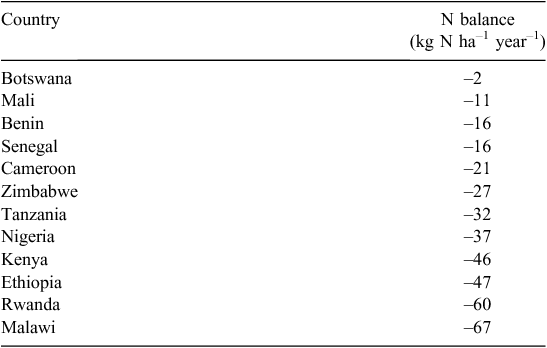
|
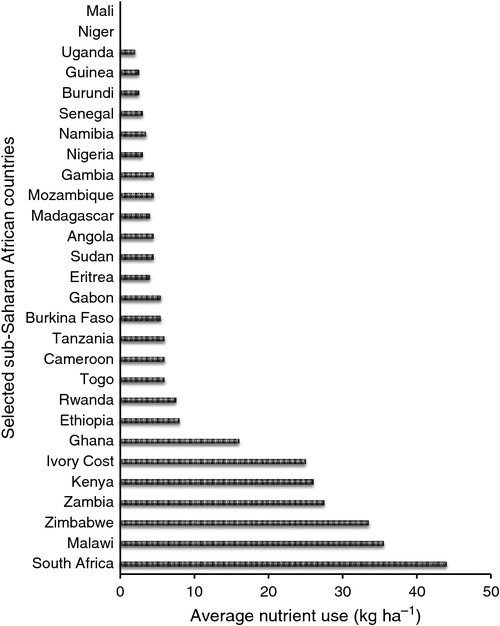
|
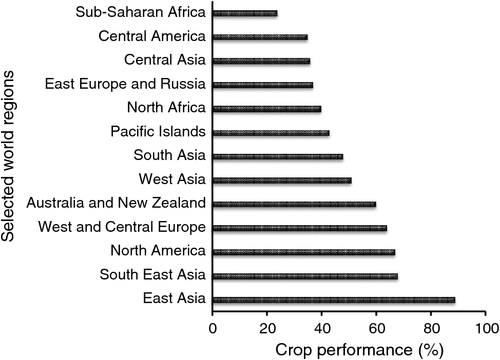
|
Poor quality of N inputs
Recent studies recognised the need to address the quality issues of agricultural inputs including N sources in SSA countries to improve crop productivity. In Uganda, for example, Bold et al. (2015) showed that urea sold in the fertiliser marketplace contained 31% less N on average. Analysis results for 369 samples showed all of them with N content below the authentic urea fertiliser grade (Fig. 3). They also demonstrated significant yield and profitability losses from the use of adulterated urea products in field experiments. The quality issues also affect other N inputs like rhizobial inoculants. In a project-driven marketplace monitoring study in Ethiopia, Kenya, and Nigeria, Jefwa et al. (2014) evaluated over 22 rhizobial inoculants and concluded that ~40% neither contained the declared active ingredients nor performed as claimed. Other inputs such as animal manures contain little N due to poor feed quality and poor manure management (Diogo et al. 2013).
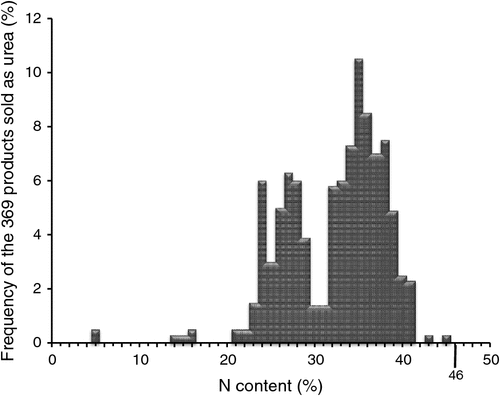
|
The poor quality of agricultural inputs stems from several factors including adulteration, sub-standard formulations, and poor handling in transportation and storage, and points to weak regulatory frameworks. Recent development initiatives have advocated for quality control of agricultural inputs through strengthening the regulatory mechanisms (Masso et al. 2013; AGRA 2014). However, operationalisation remains a challenge (Kargbo 2010). The use of poor quality inputs coupled with volatile input and output markets reduces the profitability associated with using agricultural inputs, and consequently the capacity to invest in N inputs.
Poor input and output markets
The accessibility, i.e. availability and affordability, of fertilisers is among the factors limiting fertiliser use by smallholder farmers in SSA (Mtambanengwe and Mapfumo 2009). In a study conducted in East Africa (i.e. Burundi, Kenya, Rwanda, Tanzania, and Uganda), Guo et al. (2009) demonstrated that urea application to maize was only attractive for high market access in Tanzania and Uganda at a value cost ratio of greater than 3 (Table 2). Strengthening linkages to input and output markets to increase the profitability of ISFM practices in the smallholder farming systems is crucial to improve productivity (Shiferaw et al. 2014), and consequently food and nutrition security. The high costs of inputs and low output prices in remote areas can generally be associated with transportation costs, low availability of inputs, limited market opportunities, as well as many kinds of formal and informal taxation.
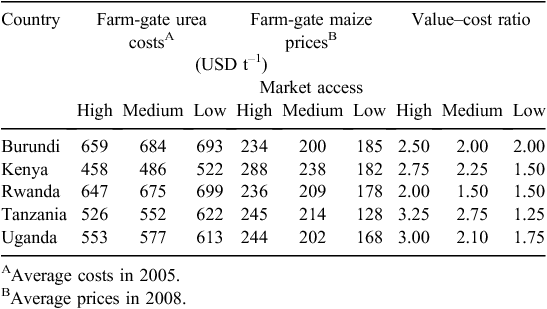
|
Malnutrition
The insufficient use of agricultural inputs particularly N has led not only to poor yields in terms of quantity, but also in terms of quality. Nitrogen is a critical nutrient in amino acids and proteins. Hence low soil N availability or use of N inputs would result in food crops with poor protein content as shown in the idealised model by Selles and Zentner (1998), and could explain the high prevalence of undernourishment in SSA (Fig. 4).
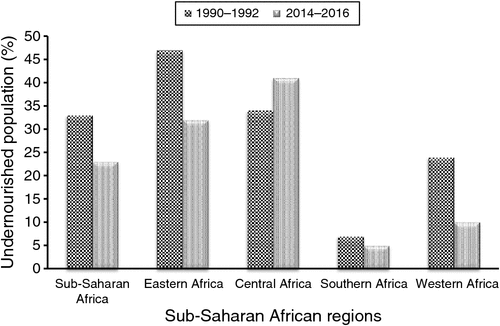
|
High N loss to the environment
Despite the low N use in food production, significant N losses still occur in SSA and exacerbate N depletion from agricultural lands. For instance, atmospheric deposition of N in SSA is equivalent to the current rate of fertiliser use, i.e. 4–15 kg N ha–1 year–1 (Galy-Lacaux and Delon 2014; Vet et al. 2014) (Fig. 5). The proportion of this N deposited on agricultural land represents a significant N input. It however becomes a significant risk to the environment when it ends up in water bodies or other areas where it cannot be used for plant growth. From a study by Zhou et al. (2014), atmospheric N deposition accounted for 67% (i.e. 102 Gg N year–1) of the total N loading (152 Gg N year–1) into Lake Victoria in East Africa. At the catchment scale, N loading into the terrestrial area was estimated to be 305 Gg N year–1 with 13.6% (i.e. 42 Gg N year–1) of it coming from oxidised N deposition. Thus, direct atmospheric N deposition into the lake represented 71% of the total atmospheric N deposition (i.e. 144 Gg N year–1) into the catchment (Fig. 6). Very little of the remainder (29%) benefited crop production as it was also deposited on several non-agricultural land use types such as settlements, roads, and marginal lands.
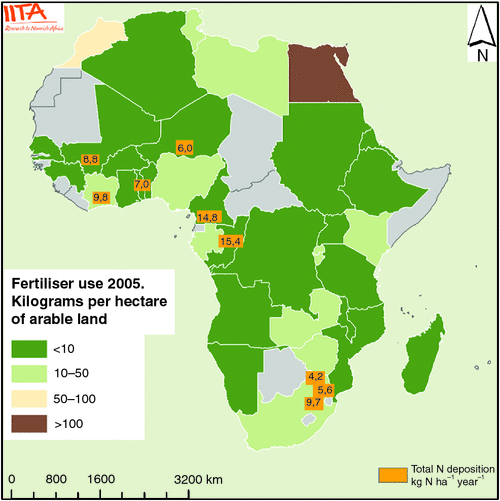
|
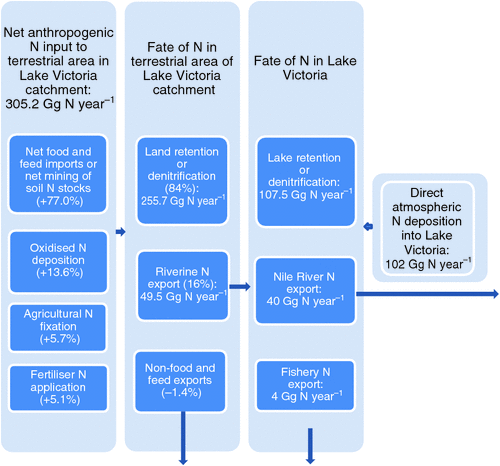
|
Based on an assessment conducted in South Africa, Lemley et al. (2014) reported that when there are no other limiting factors, concentrations of 400 and 30 µg L–1 of total dissolved N and P respectively, and an N : P ratio of 7–8 on a weight basis are enough for eutrophication to occur. Preventing eutrophication requires control of both N and P loadings into water bodies (Howarth and Marino 2006). Eutrophication related to anthropogenic activities has become a serious issue in SSA and has in some cases resulted in drastic reduction of dissolved oxygen and fish populations, and proliferation of toxic cyanobacteria blooms (Nyenje et al. 2010). As reported for Lake Victoria (Kishe 2004; Odada et al. 2004), eutrophication in SSA is mainly a result of soil erosion, nutrient leaching, atmospheric N deposition, runoff of organic wastes, and poor recovery of nutrients from wastewater among other sources. Reliable estimates of the contribution of each of these sources to N load into water bodies in SSA are generally yet to be determined to better inform policy decisions intended to reduce N losses to the environment.
Selected opportunities
NUE
The NUE in cropping systems has been defined as the ratio of N removed in harvested product to the amount of N applied (Brentrup and Pallière 2006). In these systems, AEN is one of the commonly used indices of NUE. It is defined as yield gain per unit applied N and is a function of recovery efficiency of applied N (REN), i.e. the incremental N uptake per unit of N applied and the physiological efficiency of applied N (PEN); PEN being the ratio of yield gain to incremental N uptake per unit of applied N (Dobermann 2005; Ladha et al. 2005; Fageria et al. 2010). The AEN can be affected by N application methods underpinned by the 4R nutrient stewardship principles of (1) the right source of N fertiliser, (2) the right rate, (3) the right timing of application, and (4) following the right placement (Majumdar et al. 2016), as well as other factors such as abiotic and biotic stresses, and crop management practices (Dobermann 2005).
Improved agronomic interventions
In addition to ‘too little’ N use for production in most SSA countries, AEN in smallholder farmers’ fields is also low because of poor agronomic practices including blanket fertiliser recommendations, fertiliser application rates that are too low to result in significant yields, and unbalanced fertilisation where the focus is put, for instance, on NPK without secondary or micronutrients (Fig. 7). Even when the assessment is limited to N, P, and K fertilisers, studies conducted in multiple locations in India have demonstrated that application of P and K in addition to N significantly increases the AEN (Table 3). Recent interventions in SSA, including ISFM (i.e. improved seeds, use of balanced fertilisation, organic inputs, liming materials, water management, and appropriate tillage practices among others) showed that AEN could be doubled when good agronomic practices were adopted (Vanlauwe et al. 2015). For instance, the simple adoption of improved crop varieties like maize could significantly improve AEN under conducive agro-climatic conditions (Fig. 8). Therefore, ISFM could be useful for narrowing current yield gaps (Mutegi and Zingore 2014).
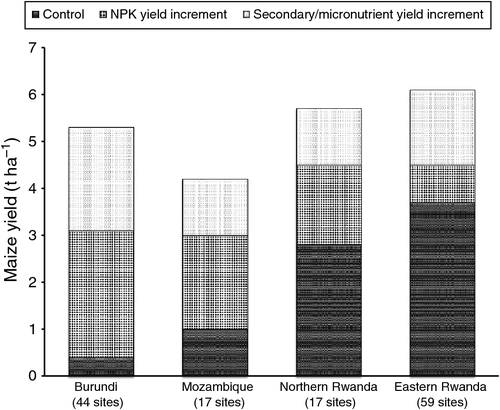
|
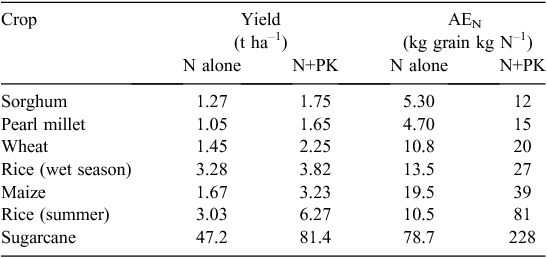
|
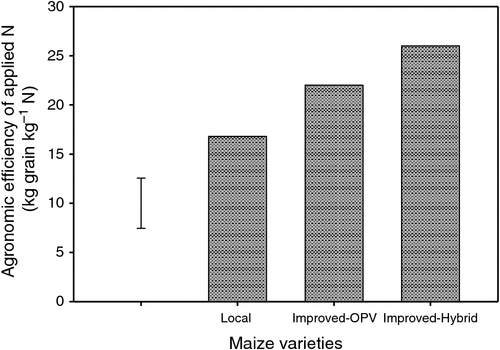
|
In addition to applying the right rate of N in the context of ISFM, timing of N fertiliser including split applications, can both improve yields and protein content (Table 4). Effective split application reduces N losses as the timing and rate for each application are adjusted to target the various demand peaks for N by the crop of interest during the growing season. Conversely, utilisation of high N rates to meet the crop N requirement in one single application generally results in increased N leaching and reduced crop REN (Fig. 9). As smallholder farmers in selected SSA countries like Kenya have started adopting the practice of split application of N for some crops such as maize, there is a need for more investments in capacity building for farmers and supportive institutional systems that will enhance proper fertiliser N application and consequently AEN.

|

|
However, the dilemma is that in SSA, farming is mainly practiced by resource-poor smallholder farmers who cannot afford most of the inputs at the actual market prices (Alobo Loison 2015). Similarly, there are no systematic policies to encourage (1) recycling of organic wastes from cities, (2) recovering nutrients from wastewater, and (3) collecting municipal sewage sludge for use on agricultural lands where they are needed. The N from those sources is either lost to landfill or discharged to water bodies and contributes to environmental pollution. Quantification of such N losses to inform policy decisions related to N recycling in food production is required.
N budgets and N footprint
In addition to AEN, indices related to environmental sustainability like N budgets (Leip et al. 2011; Eurostat 2013; Özbek and Leip 2015) and N footprint (Galloway et al. 2014; Hutton et al. 2017) are important for informing practices and policies intended to minimise N loss to the environment, while optimising crop and energy production. Good N management must therefore reduce both N accumulation (Vitousek et al. 2009; Leip et al. 2011) and N mining (Edmonds et al. 2009; Bekunda et al. 2010; Kihara et al. 2015), which can be detected through N budgets, as both have negative environmental impacts. The former could result in losses to the environment and contributing to greenhouse gases, soil acidification, and eutrophication among others, whereas the latter could result in low crop productivity. Comprehensive quantification of all inputs and outputs is required to construct accurate N budgets and to estimate AEN. For instance, Özbek and Leip (2015) demonstrated the importance of including soil N stock change in N budgets to minimise overestimation of N surplus and underestimating NUE. Soil N mining could be overestimated if N inputs from irrigation water, rainfall, crop residue, biological N fixation, and atmospheric deposition are ignored, but could be underestimated if losses through leaching, erosion, runoff, volatilisation, and denitrification are ignored (Majumdar et al. 2016).
The N footprint tool is useful for identifying hotspots of N losses to the environment, simulating mitigation options, and informing policy decisions for good N management through raising awareness of social responsibilities (Galloway et al. 2014; Davidson et al. 2016). The application of the tool showed that in many countries the largest portion of the N footprint was associated with food production, with N accumulation in selected countries like the United States of America, whereas N mining occurred in countries like Tanzania in SSA (Hutton et al. 2017). Nitrogen footprint assessments would therefore represent a great opportunity to reduce N mining in SSA through identification of potential N available for recycling in crop production.
Innovation advances
In addition to adoption of good agronomic practices like ISFM to improve AEN, exploration of innovations that are cost effective to maximise the return on investment would be critical in the context of resource-poor smallholder farmers. One of the innovations that has proven cost effective in smallholder farming systems is the use of ‘urea briquettes’ mainly in rice production, although similar results have been reported in maize (Table 5). The potential has not only been shown in SSA, but also in Asian countries like Bangladesh (Huda et al. 2016). Although the innovation is labour-intense, the improved canopy reduces the labour required for weeding. Other slow N release innovations (e.g. inhibitors and N coating) represent a comparative advantage; however, their costs would generally represent a challenge for resource-poor smallholder farmers in SSA.
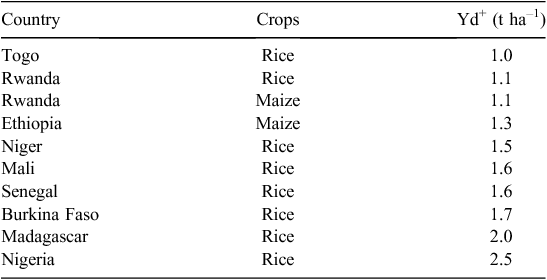
|
Another innovation gaining momentum in SSA is the incorporation of bio-fertilisers such as rhizobial inoculants in ISFM practices, which not only benefit legume crops, but also subsequent crops in the rotation. Under conducive conditions, legume crops can fix more N than they require, and therefore leave behind residual N (Table 6, Fig. 10). The performance of biological N fixation (BNF), however, depends on the interaction of legume genotype, rhizobium strain, environmental conditions like soil fertility, and crop management such as planting dates, weeding, and spacing (Woomer et al. 2014). Low BNF, i.e. <5 kg ha–1, has been reported when soil fertility is poor and no-amendment is applied (Mapfumo 2011). The success of rhizobial inoculation in SSA will therefore depend on proper diagnosis of BNF-limiting factors for local adaptation and availability of effective strains for widely grown grain legumes. This would require enabling policies to facilitate smallholder farmers’ access to high quality inputs and awareness creation about good agronomic practices to optimise the performance of inputs.
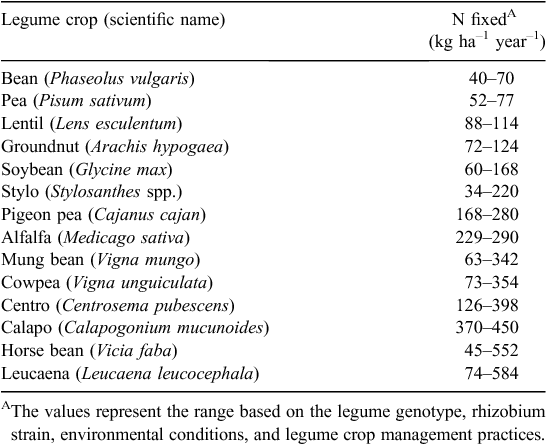
|
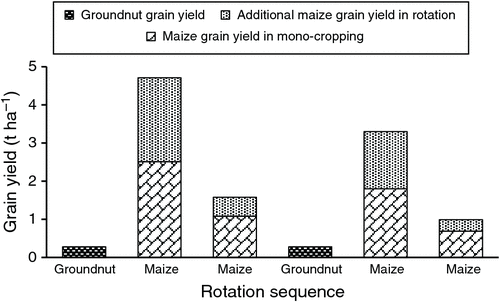
|
Policies and innovation platforms to improve AEN
Enabling policies targeting resource-poor smallholder farmers in SSA would be critical to addressing the barriers to adoption of good agricultural practices aimed at increasing AEN. Most of the constraints are of agronomic or socioeconomic nature. Agronomic policies must for instance address the following:
-
weak extension services to ensure good agronomic practices are understood and adopted by farmers (Akpan et al. 2012a, 2012b; Kiptot et al. 2016)
-
poor quality of agricultural inputs not only for enhancing efficiency but also ensuring that farmers gain confidence in the products (Masso et al. 2013; Bold et al. 2015)
-
blanket fertiliser recommendations by investing in research to generate site and crop-specific recommendations (Mutegi and Zingore 2014)
-
N recycling from various organic wastes and N recovery from wastewater for use on agricultural lands importantly, returning N from cities to rural agricultural areas, from where N is generally exported in food products
Similarly, socioeconomic policies are required to improve:
-
market opportunities by controlling input costs and output prices to increase the profitability of using N inputs and reduce the volatility of produce prices, thereby minimising risks, and consequently triggering adoption (Kelly 2006; Dittoh et al. 2012)
-
the supply chain of inputs and outputs through improved market systems and reduced transportation costs and losses (Bumb et al. 2011; Akpan et al. 2012a)
-
infrastructure conditions to cut input and output transportation costs and enhance storage conditions to minimise input deterioration and post-harvest losses
-
the financial capacity or access to credit for resource-poor smallholder farmers (Akudugu et al. 2012)
-
land tenure systems for farmers to ensure ownership and thus create incentive for farmers to move towards sustainable intensification (TerrAfrica 2009)
Currently, some of the policies have been developed in selected SSA countries, but operationalisation remains a critical issue (TerrAfrica 2009; Kargbo 2010). Future interventions must ensure that novel and existing policies are strengthened and effectively implemented. Hence, innovation platforms would be crucial to inform policy decisions in a participatory manner to improve accessibility to, and proper use of, high quality agricultural inputs including N for sustainable intensification as well as production of sufficient, nutritious, and safe food.
Research capacity and future perspectives
In SSA, limited life-cycle assessment of N has been undertaken as a consequence of poor research capacity and the research priorities of most national and international research organisations. In general, human choices in terms of food consumption drive N use, particularly for food production (Sutton et al. 2013). Selected investigations in SSA have been made to improve AEN; however, quantification of N flows in the whole food supply chain has been too scarce to be representative, which has resulted in many uncertainties in N budgets (Rufino et al. 2014; Zhou et al. 2014). Consequently, key intervention areas to optimise AEN and minimise N losses to the environment are often not well understood, particularly at national, regional, and continental scales. Based on current challenges and opportunities related to N management in SSA, priorities to improve food security could, among others, include the following:
-
using a participatory approach to determine segments of the whole food supply chain with low NUE (i.e. N footprint) and developing solutions to address the underlying causes to optimise food production
-
developing crop-specific N application rates in the context of ISFM to improve food production and quality, while minimising environmental pollution
-
developing smart subsidies for N inputs that promote N use, conducive to public–private partnerships, and minimise dependence on public support over time
-
advocating for market policies conducive to increased profitability of N use for food production
-
conducting comprehensive national, regional, and continental N budgets to determine (1) the various sources of N, (2) REN and AEN for each source of N, (3) the types of N losses (i.e. N loss pathways) and magnitude, and (4) effective mitigation approaches for each type of loss to optimise food production, while minimising pollution
-
assessing the quality of emerging N inputs (e.g. bio-fertilisers) to improve effectiveness, while preventing food contamination and environmental pollution
Conclusion
Sub-Saharan Africa is facing a challenge of ‘too little’ N for food production and ‘too much’ N lost to the environment. Appropriate interventions are required to reverse the trend and so meet the food demand of this region, which has the highest global population growth. This is particularly critical as the population pressure will exacerbate land degradation and N depletion if adequate solutions are not implemented. Participatory development of solutions for improved N management would be crucial to inform market policies intended to support resource-poor smallholder farmers and increase the profitability of N use for food production. Importantly, in addition to improving accessibility to N inputs, farmers will have to be empowered with relevant knowledge and the know-how and financing opportunities for the adoption of N inputs in the context of ISFM to be able to produce enough nutritious food, and diversify production systems to meet dietary needs. Public–private partnerships would therefore be critical to ensure that the private sector contributes to the capacity building of farmers and extension services, and that governments increase agricultural budgets, to effectively increase AEN, while minimising environmental pollution.
Acknowledgements
The authors would like to thank the organising committee of the 7th Conference of the International Nitrogen Initiative (INI) in Melbourne, Australia for the opportunity to present the African perspective of N management. They also thank all the stakeholders who volunteered data to show the case or whose publication was cited in this paper. The facilitation of the International Institute of Tropical Agriculture (IITA), the INI, and the Bill and Melinda Gates Foundation through COMPRO-II (OPPGD1398) is also highly appreciated.
References
AGRA (2014) ‘An assessment of agricultural policies and regulatory constraints to agribusiness investment in Burkina Faso, Ethiopia, Ghana, Nigeria and Tanzania.’ (Alliance for a Green Revolution in Africa (AGRA): Nairobi)Akpan SB, Nkanta VS, Essien UA (2012a) A double-hurdle model for fertilizer adoption and optimum use among farmers in southern Nigeria. Tropicultura 30, 249–253.
Akpan SB, Udoh EJ, Nkanta VS (2012b) Factors influencing fertilizer use intensity among smallholder crop farmers in Abak agricultural zone in Akwa Ibom State, Nigeria. Journal of Biology, Agriculture and Healthcare 2, 54–65.
Akudugu MA, Guo E, Dadzie SK (2012) Adoption of modern agricultural production technologies by farm households in Ghana: what factors influence their decisions? Journal of Biology, Agriculture and Healthcare 2, 1–13.
Alobo Loison S (2015) Rural livelihood diversification in sub-Saharan Africa: a literature review. The Journal of Development Studies 51, 1125–1138.
| Rural livelihood diversification in sub-Saharan Africa: a literature review.Crossref | GoogleScholarGoogle Scholar |
Argus Consulting Services (2016) Closing the yield gap in sub-Saharan Africa. Available at https://www.argusmedia.com/~/media/files/pdfs/white-paper/sub-saharan-africa-closing-the-yield-gap.pdf/?la=en [verified 26 July 2016]
Bekunda M, Sanginga N, Woomer P (2010) Restoring soil fertility in sub-Saharan Africa. Advances in Agronomy 108, 183–236.
| Restoring soil fertility in sub-Saharan Africa.Crossref | GoogleScholarGoogle Scholar |
Bold T, Kaizzi KC, Svensson J, Yanagizawa-Drott D (2015) Low quality, low returns, low adoption: Evidence from the market for fertilizers and hybrid seed in Uganda. Policy Brief. International Growth Centre, London.
Brentrup F, Pallière C (2006) Nitrogen use efficiency as an agro-environmental indicator. Available at http://www.oecd.org/tad/sustainable-agriculture/44810433.pdf [verified 23 May 2015]
Bumb BL, Johnson ME, Fuentes PA (2011) Policy options for improving regional fertilizer markets in West Africa. IFPRI discussion paper 01084. International Food Policy Research Institute, Washington, DC.
Chianu JN, Chianu JN, Mairura F (2012) Mineral fertilizers in the farming systems of sub-Saharan Africa – a review. Agronomy for Sustainable Development 32, 545–566.
| Mineral fertilizers in the farming systems of sub-Saharan Africa – a review.Crossref | GoogleScholarGoogle Scholar | 1:CAS:528:DC%2BC38XksVOgtrs%3D&md5=126ebc5015c3d8d5d8ace85e7903ddd3CAS |
Davidson EA, Nifong RL, Ferguson RB, Palm C, Osmond DL, Baron JS (2016) Nutrients in the nexus. Journal of Environmental Studies and Sciences 6, 25–38.
| Nutrients in the nexus.Crossref | GoogleScholarGoogle Scholar |
Diogo RVC, Schlecht E, Buerkert A, Rufino MC, van Wijk MT (2013) Increasing nutrient use efficiency through improved feeding and manure management in urban and peri-urban livestock units of a West African city: a scenario analysis. Agricultural Systems 114, 64–72.
| Increasing nutrient use efficiency through improved feeding and manure management in urban and peri-urban livestock units of a West African city: a scenario analysis.Crossref | GoogleScholarGoogle Scholar |
Dittoh S, Omotosho O, Belemvire A, Akuriba M, Haider K (2012) Improving the effectiveness, efficiency and sustainability of fertilizer use in sub-Saharan Africa. Briefing Paper Number 3. Global Development Network, New Delhi.
Dobermann A (2005) ‘Nitrogen use efficiency – state of the art.’ (Agronomy and Horticulture – Faculty Publications, University of Nebraska: Lincoln)
Edmonds DE, Abreu SL, West A, Caasi DR, Conley TO, Daft MC, Desta B, England BB, Farris CD, Nobles TJ, Patel NK, Rounds EW, Sanders BH, Shawaqfeh SS, Lakmini , Lokuralalage , Manandhar R, Raun WR (2009) Cereal nitrogen use efficiency in sub-Saharan Africa. Journal of Plant Nutrition 32, 2107–2122.
| Cereal nitrogen use efficiency in sub-Saharan Africa.Crossref | GoogleScholarGoogle Scholar | 1:CAS:528:DC%2BD1MXhtlKrt7fP&md5=15264689bff35ba21aabc38034f7dc92CAS |
Eurostat (2013) ‘Nutrient budgets, EU-27, Norway, Switzerland. Methodology and handbook.’ Version 1.02. (Eurostat/OECD: Luxembourg)
Fageria NK, de Morais OP, dos Santos AB (2010) Nitrogen use efficiency in upland rice genotypes. Journal of Plant Nutrition 33, 1696–1711.
| Nitrogen use efficiency in upland rice genotypes.Crossref | GoogleScholarGoogle Scholar | 1:CAS:528:DC%2BC3cXpt12rsL0%3D&md5=a927c1e90be472d9c1158dc14fe7055bCAS |
Fairhurst T (2012) ‘Handbook for integrated soil fertility management.’ (CAB International: Nairobi)
FAO (1984) ‘Legume inoculants and their use.’ (FAO Fertilizer and Plant Nutrition Service: Rome)
Galloway JN, Winiwarter W, Leip A, Leach AM, Bleeker A, Erisman JW (2014) Nitrogen footprints: past, present and future. Environmental Research Letters 9, 115003
| Nitrogen footprints: past, present and future.Crossref | GoogleScholarGoogle Scholar |
Galy-Lacaux C, Delon C (2014) Nitrogen emission and deposition budget in West and Central Africa. Environmental Research Letters 9, 125002
| Nitrogen emission and deposition budget in West and Central Africa.Crossref | GoogleScholarGoogle Scholar |
Ghosh BN, Singh RJ, Mishra PK (2015) Soil and inputs management options for increasing nutrient use efficiency. In ‘Nutrient use efficiency: from basics to advances’. (Eds A Rakshit, HB Singh, A Sen) pp. 17–27. (Springer India: New Delhi)
Giller KE, Tittonell P, Rufino MC, van Wijk MT, Zingore S, Mapfumo P, Adjei-Nsiah S, Herrero M, Chikowo R, Corbeels M, Rowe EC, Baijukya F, Mwijage A, Smith J, Yeboah E, van der Burg WJ, Sanogo OM, Misiko M, de Ridder N, Karanja S, Kaizzi C, K’ungu J, Mwale M, Nwaga D, Pacini C, Vanlauwe B (2011) Communicating complexity: Integrated assessment of trade-offs concerning soil fertility management within farming systems to support innovation and development. Agricultural Systems 104, 191–203.
| Communicating complexity: Integrated assessment of trade-offs concerning soil fertility management within farming systems to support innovation and development.Crossref | GoogleScholarGoogle Scholar |
Guo Z, Koo J, Wood S (2009) Fertilizer profitability in East Africa: a spatially explicit policy analysis. In ‘International Association of Agricultural Economics Conference’, 16–22 August 2009, Beijing. (International Food Policy Research Institute (IFPRI): Washington DC)
Hawkesford MJ (2014) Reducing the reliance on nitrogen fertilizer for wheat production. Journal of Cereal Science 59, 276–283.
| Reducing the reliance on nitrogen fertilizer for wheat production.Crossref | GoogleScholarGoogle Scholar | 1:CAS:528:DC%2BC2cXjt1Ghtw%3D%3D&md5=0a76d389814056a2daeb3a1159e35c5eCAS |
Howarth RW, Marino R (2006) Nitrogen as the limiting nutrient for eutrophication in coastal marine ecosystems: Evolving views over three decades. Limnology and Oceanography 51, 364–376.
| Nitrogen as the limiting nutrient for eutrophication in coastal marine ecosystems: Evolving views over three decades.Crossref | GoogleScholarGoogle Scholar | 1:CAS:528:DC%2BD28XhsFaqtbo%3D&md5=3a11d478a02b9908150796312e16538dCAS |
Huda A, Gaihre YK, Islam MR, Singh U, Islam MR, Sanabria J, Satter MA, Afroz H, Halder A, Jahiruddin M (2016) Floodwater ammonium, nitrogen use efficiency and rice yields with fertilizer deep placement and alternate wetting and drying under triple rice cropping systems. Nutrient Cycling in Agroecosystems 104, 53–66.
| Floodwater ammonium, nitrogen use efficiency and rice yields with fertilizer deep placement and alternate wetting and drying under triple rice cropping systems.Crossref | GoogleScholarGoogle Scholar | 1:CAS:528:DC%2BC28XhtV2rsbk%3D&md5=a8676b81660ba889f15e7699c46f3ef3CAS |
Hutton MO, Leach AM, Leip A, Galloway JN, Bekunda M, Sullivan C, Lesschen JP (2017) Toward a nitrogen footprint calculator for Tanzania. Environmental Research Letters 12, 034016
| Toward a nitrogen footprint calculator for Tanzania.Crossref | GoogleScholarGoogle Scholar |
Jefwa JM, Pypers P, Jemo M, Thuita M, Mutegi E, Laditi MA, Faye A, Kavoo A, Munyahali W, Herrmann L, Atieno M, Okalebo JR, Yusuf A, Ibrahim A, Ndung’u-Magiroi KW, Asrat A, Muletta D, Ncho C, Kamaa M, Lesueur D (2014) Do commercial biological and chemical products increase crop yields and economic returns under smallholder farmers’ conditions? In ‘Challenges and opportunities for agricultural intensification of humid highland systems of sub-Saharan Africa’. (Eds B Vanlauwe, P van Asten, G Blomme) pp. 81–96. (Springer International Publishing: Cham)
Kargbo J (2010) ‘Agricultural input business development in Africa: Opportunities, issues and challenges.’ (United Nations Economic Commission for Africa – Southern Africa Office: Lusaka)
Kelly VA (2006) Factors affecting demand for fertilizer in sub-Saharan Africa. Agriculture and rural development discussion paper 23. Agriculture and Rural Development Department, World Bank, Washington, DC.
Kihara J, Tamene LD, Massawe P, Bekunda M (2015) Agronomic survey to assess crop yield, controlling factors and management implications: a case-study of Babati in northern Tanzania. Nutrient Cycling in Agroecosystems 102, 5–16.
| Agronomic survey to assess crop yield, controlling factors and management implications: a case-study of Babati in northern Tanzania.Crossref | GoogleScholarGoogle Scholar |
Kiptot E, Karuhanga M, Franzel S, Nzigamasabo PB (2016) Volunteer farmer-trainer motivations in East Africa: practical implications for enhancing farmer-to-farmer extension. International Journal of Agricultural Sustainability 14, 339–356.
| Volunteer farmer-trainer motivations in East Africa: practical implications for enhancing farmer-to-farmer extension.Crossref | GoogleScholarGoogle Scholar |
Kishe MA (2004) Physical and chemical characteristics of water in selected locations in Lake Victoria, Tanzania. Tanzania Journal of Science 30, 65–72.
Ladha JK, Pathak H, Krupnik TJ, Six J, van Kessel C (2005) Efficiency of fertilizer nitrogen in cereal production: retrospects and prospects. Advances in Agronomy 87, 85–156.
| Efficiency of fertilizer nitrogen in cereal production: retrospects and prospects.Crossref | GoogleScholarGoogle Scholar | 1:CAS:528:DC%2BD1cXitlahsLg%3D&md5=ccb90455d639595d8d0a7e0c4a01fe68CAS |
Leip A, Britz W, Weiss F, de Vries W (2011) Farm, land, and soil nitrogen budgets for agriculture in Europe calculated with CAPRI. Environmental Pollution 159, 3243–3253.
| Farm, land, and soil nitrogen budgets for agriculture in Europe calculated with CAPRI.Crossref | GoogleScholarGoogle Scholar | 1:CAS:528:DC%2BC3MXhtF2rtbzN&md5=39b020bee5fff48a94780baea8acc9e4CAS |
Leip A, Leach A, Musinguzi P, Tumwesigye T, Olupot G, Tenywa JS, Mudiope J, Hutton O, Cordovil CMDS, Bekunda M, Galloway J (2014) Nitrogen-neutrality: a step towards sustainability. Environmental Research Letters 9, 115001
| Nitrogen-neutrality: a step towards sustainability.Crossref | GoogleScholarGoogle Scholar |
Lemley DA, Taljaard S, Adams JB, Strydom N (2014) Nutrient characterization of river inflow into the estuaries of the Gouritz water management area, South Africa. African Journals Online 40, 687–698.
Liu J, You L, Amini M, Obersteiner M, Herrero M, Zehnder JB, Yang H (2010) A high-resolution assessment on global nitrogen flow in cropland. Proceedings of the National Academy of Sciences of the United States of America 107, 8035–8040.
| A high-resolution assessment on global nitrogen flow in cropland.Crossref | GoogleScholarGoogle Scholar | 1:CAS:528:DC%2BC3cXls1Shsr4%3D&md5=e455f354610589e0618f4021ad19470bCAS |
LVBC (2012) ‘A basin-wide strategy for sustainable land management in the Lake Victoria Basin.’ (Lake Victoria Basin Commission (LVBC): Kisumu)
Majumdar K, Sanyal SK, Dutta SK, Satyanarayana T, Singh VK (2016) Nutrient mining: addressing the challenges to soil resources and food security. In ‘Biofortification of food crops’. (Eds U Singh, CS Praharaj, SS Singh, NP Singh) pp. 177–198. (Springer India: Delhi)
Mapfumo P (2011) Comparative analysis of the current and potential role of legumes in integrated soil fertility management in Southern Africa. In ‘Fighting Poverty in Sub-Saharan Africa: the multiple roles of legumes in integrated soil fertility management’. (Eds A Bationo, B Waswa, JM Okeyo, F Maina, J Kihara, U Mokwunye) pp. 175–200. (Springer: Dordrecht)
Marler JB, Wallin JR (2006) ‘Human health, the nutritional quality of harvested food and sustainable farming systems.’ (Nutrition Security Institute: Bellevue)
Masso C, Jefwa JM, Jemo M, Thuita M, Tarus D, Vanlauwe B (2013) Impact of inadequate regulatory frameworks on the adoption of bio-fertilizers (e.g. PGPR) technologies: a case study of sub-Saharan Africa. In ‘Recent advances in biofertilizers and biofungicides (PGPR) for sustainable agriculture’. (Eds MS Reddy, RI Ilao, PS Faylon, WD Dar, R Sayyed, H Sudini, KVK Kumar, A Armanda) pp. 276–286. (CAB Direct: Oxfordshire)
Mtambanengwe F, Mapfumo P (2009) Combating food insecurity on sandy soils in Zimbabwe: the legume challenge. Symbiosis 48, 25–36.
| Combating food insecurity on sandy soils in Zimbabwe: the legume challenge.Crossref | GoogleScholarGoogle Scholar |
Mutegi J, Zingore S (2014) Closing yield gaps in sub-Saharan Africa through integrated soil fertility management. ISFM Policy Highlights No. 1. International Plant Nutrition Institute (IPNI), Nairobi.
Nezomba H, Mtambanengwe F, Tittonell P, Mapfumo P (2015) Point of no return? Rehabilitating degraded soils for increased crop productivity on smallholder farms in eastern Zimbabwe. Geoderma 239–240, 143–155.
| Point of no return? Rehabilitating degraded soils for increased crop productivity on smallholder farms in eastern Zimbabwe.Crossref | GoogleScholarGoogle Scholar |
Nkonya E, Place F, Pender J, Mwanjololo M, Okhimamhe A, Kato E, Crespo S, Ndjeunga J, Traore S (2011) Climate risk management through sustainable land management in sub-Saharan Africa. IFPRI Discussion Paper. Washington, DC.
Nyenje PM, Foppen JW, Uhlenbrook S, Kulabako R, Muwanga A (2010) Eutrophication and nutrient release in urban areas of sub-Saharan Africa – a review. The Science of the Total Environment 408, 447–455.
| Eutrophication and nutrient release in urban areas of sub-Saharan Africa – a review.Crossref | GoogleScholarGoogle Scholar | 1:CAS:528:DC%2BD1MXhsVyqs7%2FL&md5=2381c60eda7f958f266df5de29e6c507CAS |
Odada EO, Olago DO, Kulindwa K, Ntiba M, Wandiga S (2004) Mitigation of environmental problems in Lake Victoria, East Africa: causal chain and policy option analyses. Ambio 33, 13–23.
| Mitigation of environmental problems in Lake Victoria, East Africa: causal chain and policy option analyses.Crossref | GoogleScholarGoogle Scholar |
Özbek FŞ, Leip A (2015) Estimating the gross nitrogen budget under soil nitrogen stock changes: a case study for Turkey. Agriculture, Ecosystems & Environment 205, 48–56.
| Estimating the gross nitrogen budget under soil nitrogen stock changes: a case study for Turkey.Crossref | GoogleScholarGoogle Scholar |
Perez CM, Juliano BO, Liboon SP, Alcantara JM, Cassman KG (1996) Effects of late nitrogen fertilizer application on the head rice yield, protein content, and grain quality of rice. Cereal Chemistry 73, 556–560.
Rufino MC, Brandt P, Herrero M, Butterbach-Bahl K (2014) Reducing uncertainty in nitrogen budgets for African livestock systems. Environmental Research Letters 9, 105008
| Reducing uncertainty in nitrogen budgets for African livestock systems.Crossref | GoogleScholarGoogle Scholar |
Selles F, Zentner RP (1998) ‘Nitrogen management for yield and protein in wheat in the brown soil zone.’ (Agriculture and Agri-Food Canada: Swift Current)
Shiferaw B, Tesfaye K, Kassie M, Abate T, Prasanna BM, Menkir A (2014) Managing vulnerability to drought and enhancing livelihood resilience in sub-Saharan Africa: Technological, institutional and policy options. Weather and Climate Extremes 3, 67–79.
| Managing vulnerability to drought and enhancing livelihood resilience in sub-Saharan Africa: Technological, institutional and policy options.Crossref | GoogleScholarGoogle Scholar |
Sutton MA, Bleeker A, Howard CM, Bekunda M, Grizzetti B, de Vries W, van Grinsven HJM, Abrol YP, Adhya TK, Billen G, Davidson EA, Datta A, Diaz R, Eisman JW, Liu XJ, Oenema O, Palm C, Raghuram N, Reis S, Scholz RW, Sims T, Westhoek H, Zhang FS, Ayyappan S, Bouwman AF, Bustamante M, Fowler D, Galloway JN, Gavito ME, Garnier J, Greenwood S, Hellums DT, Holland M, Hoysall C, Jaramillo VJ, Klimont Z, Ometto JP, Pathak H, Plocq Fichetet V, Powlson D, Ramakrishna K, Roy A, Sanders K, Sharma C, Singh B, Singh U, Yan XY, Zhang Y (2013) ‘Our nutrient world: the challenge to produce more food and energy with less pollution.’ (Centre for Ecology and Hydrology: Edinburgh)
TerrAfrica (2009) ‘Policy and financing for sustainable land management in sub-Saharan Africa – lessons and guidance for action.’ (The Global Mechanism of the UNCCD and Oxford Policy Management: Midrand)
Tittonell P, Giller KE (2013) When yield gaps are poverty traps: the paradigm of ecological intensification in African smallholder agriculture. Field Crops Research 143, 76–90.
| When yield gaps are poverty traps: the paradigm of ecological intensification in African smallholder agriculture.Crossref | GoogleScholarGoogle Scholar |
Vanlauwe B, Kihara J, Chivenge P, Pypers P, Coe R, Six J (2011) Agronomic use efficiency of N fertilizer in maize-based systems in sub-Saharan Africa within the context of integrated soil fertility management. Plant and Soil 339, 35–50.
| Agronomic use efficiency of N fertilizer in maize-based systems in sub-Saharan Africa within the context of integrated soil fertility management.Crossref | GoogleScholarGoogle Scholar | 1:CAS:528:DC%2BC3MXmsVCgtw%3D%3D&md5=a4b7c45137143233ea65d939885eaceeCAS |
Vanlauwe B, Descheemaeker K, Giller KE, Huising J, Merckx R, Nziguheba G, Wendt J, Zingore S (2015) Integrated soil fertility management in sub-Saharan Africa: unraveling local adaptation. Soil (Göttingen) 1, 491–508.
| Integrated soil fertility management in sub-Saharan Africa: unraveling local adaptation.Crossref | GoogleScholarGoogle Scholar |
Vet R, Richard S, Carou AS, Shaw M, Ro C-U, Aas W, Baker A, Bowersox VC, Dentener F, Galy-Lacaux C, Hou A, Pienaar JJ, Gillett R, Forti MC, Gromov S, Hara H, Khodzher T, Mahowald NM, Nickovic S, Rao PSP, Reid NW (2014) A global assessment of precipitation chemistry and deposition of sulfur, nitrogen, sea salt, base cations, organic acids, acidity and pH, and phosphorus. Atmospheric Environment 93, 3–100.
| A global assessment of precipitation chemistry and deposition of sulfur, nitrogen, sea salt, base cations, organic acids, acidity and pH, and phosphorus.Crossref | GoogleScholarGoogle Scholar | 1:CAS:528:DC%2BC2cXmtlSrtbw%3D&md5=26eea53bd555d59ee3556c89208eb4dbCAS |
Vitousek PM, Naylor R, Crews T, David MB, Drinkwater LE, Holland E, Johnes PJ, Katzenberger J, Martinelli LA, Matson PA, Nziguheba G, Ojima D, Palm CA, Robertson GP, Sanchez PA, Townsend AR, Zhang FS (2009) Nutrient imbalances in agricultural development. Science 324, 1519–1520.
| Nutrient imbalances in agricultural development.Crossref | GoogleScholarGoogle Scholar | 1:CAS:528:DC%2BD1MXnvVKju7o%3D&md5=3e5037f54c23ac97f9f3538a19f82bdcCAS |
Waddington S, Sakala D, Mekuria M (2004) Progress in lifting soil fertility in southern Africa. In ‘Fourth International Crop Science Congress: new directions for a diverse planet’, 26 September–1 October 2014, Brisbane. (CIMMYT African Livelihoods Program: Harare, Zimbabwe)
Wanzala M (2011) ‘The Abuja declaration on fertilizers for an African green revolution – status of implementation at regional and national levels.’ (The New Partnership for Africa’s Development (NEPAD): Johannesburg)
Woomer P, Huising J, Giller K, Baijukya F, Kantengwa S, Vanlauwe B, Boahen S, de Wolf J, Franke L, Abaidoo R, Dianda M, Sanginga JM, Ronner E, van den Brand G, Schilt C (2014) N2Africa Final Report of the First Phase 2009–2013 – Putting nitrogen fixation to work for smallholder farmers in Africa. Wageningen University, Wageningen.
Zhou M, Brandt P, Pelster D, Rufino MC, Robinson T, Butterbach-Bahl K (2014) Regional nitrogen budget of the Lake Victoria Basin, East Africa: syntheses, uncertainties, and perspectives. Environmental Research Letters 9, 105009
| Regional nitrogen budget of the Lake Victoria Basin, East Africa: syntheses, uncertainties, and perspectives.Crossref | GoogleScholarGoogle Scholar |


